Cover Story: Wellness in MS
The Importance of Nutrition, Exercise, and Other Vital Strategies
In this article
Unlocking The Mystery Of Nutrition
Popular Diets
The Benefits Of Exercise
How Does Activity Affect Mood?
How The Benefits Of Exercise Piece Together For Overall Health
Maintain Your Frame

Written by Amy McKay, M Ed, CSCS, CES
Reviewed by Jack Burks, MD
Allen C. Bowling, MD, PhD
Lacey Bromley, PT, DPT, NCS, MSCS
Edited by Susan Courtney
UNLOCKING THE MYSTERY OF NUTRITION
Learning about Good Food Choices
“What are we having for dinner?” is probably one of the most common questions that is asked each and every evening across America. So many choices are available! Whether dining at fast-food restaurants or gourmet eateries, ordering take-out, having a pizza delivered, or cooking at home – deciding on an option can be overwhelming… much less deciding on a healthy one!
So how do we know what choices are healthy? Throughout the media, you’ll find countless diets and eating guidelines that we are encouraged to follow. Here is just a short list of the many diets that have been developed for specific groups of people… these include the Zone Diet, the Atkins Diet, the Swank Diet, the Wahls Protocol, Weight Watchers®, the Caveman Diet, gluten-free diets, vegetarian, and vegan diets. Please see the section on Popular Diets below for summaries.
And then we have the SAD Diet. The SAD Diet, aka Standard American Diet, has swept across the nation and may soon be the most popular nutrition program in the land. The SAD diet primarily consists of highly processed foods, fast-food, and food with little to no nutritional value. The SAD Diet lacks the ability to keep anyone healthy, especially if you have MS. All of these diets have left us wondering how we, as Americans, have taken the simple act of fueling our bodies and locked it in a box that would even intrigue Pandora!

ABOUT THE AUTHOR
Amy McKay is an Assistant Professor at Tarleton State University in Stephenville, Texas. She is a certified Strength and Conditioning Specialist for the National Strength and Conditioning Association, a certified Corrective Exercise Specialist with the National Association of Sports Medicine, a certified Sports Nutritionist and Specialist in Exercise Therapies with the International Sports Science Association, a certified Personal Trainer with the Aerobics and Fitness Association of America, and a Youth Nutrition Specialist with the International Youth Conditioning Association. She is an avid marathoner and tri-athlete. Amy believes that modifying exercise is necessary for everyone and strives to “find a way” for all to be involved. Her personal motto is to make every day “the best day ever!”
On the following pages are the six essential keys to good nutrition, a sample list of healthy foods, and tips for healthy eating. Two mobile-phone apps to assist with recording and learning about foods are also noted. Readers may find this information to be very helpful in designing an ideal diet plan for their own needs, under the supervision of their own doctor.
THE BASICS OF NUTRITION:
Six Essential Keys for Unlocking the Mystery
In an effort to learn more about nutrition, let’s start with the basics. Six key groups are used to categorize the food we eat. Everything we eat consists of: (1) fats, (2) carbohydrates, (3) proteins, (4) vitamins, (5) minerals, and (6) water. I also teach my clients that unprocessed foods, whole foods, and REAL foods (foods that Release Essential Antioxidants for Longevity) are a better choice when it comes to healthy eating.
Key # 1: Two Sub-Types of Fats (or Lipids)
Saturated fats are typically solid at room temperature and include margarine, shortening, lard, and butter. I recommend avoiding margarine and shortening, and lard is not a good choice for anyone given the high fat content. However, if you enjoy using butter, I recommend that you do so in moderation.
Unsaturated fats are liquid at room temperature. These are often good REAL choices and include olive oil and peanut oil. Although the following oils are unsaturated, I encourage my clients to avoid these due to their unhealthy high omega-6 ratio: canola oil, corn oil, cottonseed oil, grapeseed oil, rapeseed oil, rice bran oil, safflower oil, sesame oil, soybean oil, and sunflower oil.
Key # 2: Two Sub-Types of Carbohydrates

Complex carbohydrates are great sources of long-lasting energy. All fruits and vegetables fall under the complex carbohydrate umbrella. I frequently remind my clients that complex carbohydrates are a great source of fiber. A diet high in fiber has been shown to reduce the risk of colon cancer and will also aid in a “regular” elimination schedule! If approved by your doctor, I encourage you to consume five servings of fruit and veggies daily. Whole-grain breads, whole-grain pastas, and brown rice round out this sub-type.
Simple carbohydrates create a quick blood-sugar rush when you eat them. Overconsumption of simple carbohydrates (sugars) has been shown to increase the risk of being diagnosed with type 2 diabetes. I advocate for limiting the consumption of sugary drinks, juices, candy, cake, and all refined white flour. I’d like to offer the same suggestion in regards to eating less artificial sweeteners as well.
Key # 3: Two Sub-Types of Proteins
Complete proteins contain each of nine essential amino acids that we need to build healthy muscle tissue. All foods of animal origin are considered complete proteins. Most Americans get plenty of protein. For my clients who eat meat, I steer their grocery cart to leaner cuts of meat and low-fat dairy products. Aim for a minimum daily consumption of 55 grams of protein. The more active you are, the more protein you will need.
Incomplete proteins are also great sources of protein, even though they are missing a few amino acids. Nuts, seeds, and legumes are healthy options that complete this REAL food choice. Let’s keep eating them! By carefully combining incomplete proteins, my vegetarian clients are able to stay strong, vibrant, and healthy. If you are considering a vegan lifestyle, which means no animal products whatsoever, I recommend that you educate yourself and consult your doctor on the proper way to combine incomplete proteins to ensure your good health.
Key # 4: Two Sub-Types of Vitamins
Water-soluble vitamins simply dissolve within the body and are excreted when the body has absorbed what it needs to maintain good health. In my family, we make a conscious effort to eat healthy, but there are still pieces missing from our nutrition puzzle, so I believe in taking a daily multiple vitamin. Readers should check with their doctor to see if vitamins are appropriate for them and the medications they are taking. Water-soluble vitamins include the nine different B vitamins and Vitamin C.
Fat-soluble vitamins include Vitamins A, D, E, and K. I ensure that my clients eat healthy amounts of REAL fat in their daily diet so that these fat-soluble vitamins can work within the body. The healthy amount of REAL fat is about 2 tablespoons of foods such as olive oil, coconut oil, or nut butters spread out through your day. In our house, we enjoy adding a tablespoon of almond butter to our morning smoothies. Another easy way to get healthy fats in your diets is toss fresh vegetables in olive oil before roasting or grilling.
With regard to Vitamin D, a deficiency in this vitamin is common among individuals with MS. For that reason, Ben Greenberg, MD, of the University of Texas Southwestern Medical Center says, “More than 75 percent of our patients have suboptimal Vitamin D levels. Given changes in diet and the environment over time, we are not consuming or activating as much Vitamin D3 as we used to, hence I recommend supplementation for all of my patients [with Vitamin D deficiency] to achieve more optimal levels.”
Key # 5: Minerals
Minerals are often the lost key to unlock great nutrition. Common minerals such as calcium, potassium, and magnesium are used for good bone and teeth health, energy production, nerve and muscle function, and immune-system health. If approved by one’s doctor, I recommend that all my clients take a mineral supplement. Similar to vitamins, readers should check with their doctor to see if minerals are recommended and safe with the other medications they may be taking.
Key # 6: Water
Water is the “master key” to open up each of the above nutrients. If you are chronically dehydrated, you may be feeling weak, fatigued, drowsy, or impatient. You could also be experiencing anxiety, depression, headaches, and constipation. Dr. Greenberg explains, “We routinely live life dehydrated. This puts stresses on our body that add up over time.”
Editor’s note: While avoiding dehydration is important, too much water can create unnecessary problems for people with MSassociated bladder dysfunction. Individuals should check with their doctor to see how much water is appropriate for them.
Unlocking the Box
Now that you know the basic keys to nutrition, let’s unlock the box and begin to put a nutrition plan in action! If you are already following a diet plan under the advice of your doctor, and it is working for you – then stick with it! I applaud you for knowing what works best for your body.
EATING WITH YOUR HEAD: 10 Tips for Healthier Eating
- Eat a source of fat, protein, and complex carbohydrates at each meal.
- Eat yourmeals on smaller plates and learn the importance of portion control. A serving size of protein is the size of your palm, and the stomach is about the size of a quart-size Ziploc-type bag.
- Read the label. Most processed foods are packed with un-REAL ingredients.
- Drink adequate amounts of water.
- Ideally, choose to eat only whole grains.
- Take your grocery shopping trips when you are alert and full instead of tired and hungry.
- Eat foods that are in season, when foods are at their peak nutritional value. Find out what’s in season at bit.ly/seasonalproduceguide.
- If you are in a situation where you want to eat a decadent treat or dessert, try using the Three-Bite Strategy. Savor each of those three bites and then push it away!
- Try to eat the fruit instead of drinking the juice. Orange juice creates a sugar rush, while a whole orange provides three grams of fiber!
- Slow down your entire meal-time routine. Put your fork back down on your plate between bites. Take a sip of water between bites. Let your body tell you when it is satisfied.
If you are still trying to develop an eating strategy for optimal health, begin to pay attention to how you feel after you eat certain foods. Some foods may leave you feeling sluggish, moody, or tired. Other options will leave you feeling satiated and happy for hours! This is our goal: to help you build a meal plan that keeps you at your best.
I also recommend using MSAA’s My MS Manager mobile phone application. This valuable app is available for your mobile device at no charge to help you log your notes about diet, nutrition, and how you are feeling after eating certain things.
Another app that I encourage each of my clients to use is MyFitness Pal. In my opinion, it is your new best pal for determining calorie content and nutritional content of everything, and it’s easy to use! Both apps are free and may be downloaded from Apple or Android app stores.
Remember that no two people are exactly alike, and therefore, no two nutritional plans are exactly alike either. Unlock and open up an eating plan that puts you in the best possible health so that you can manage your MS powerfully. Unlocking the nutrition box should be FUN and delicious!
Each time I go to the grocery store, I try a new item from the produce department. New thoughts and behaviors surrounding food can be hard to create. Check out a book about nutrition, watch a healthy cooking show on TV to learn new ideas, or attend a healthy cooking class. Also, find an accountability partner. Having a buddy or a group of friends to encourage each other to eat REAL food helps to keep healthy eating habits in place.
On the previous page are healthy choices and shown below are tips for a better diet. On pages 14 through 16 are overviews of several popular diets. Please note that while no single diet has been proven to slow the course of MS, healthy eating in general may be beneficial for individuals with MS – both in terms of better overall health as well as a reduction in the risk of other medical conditions.
Popular Diets
Several well-known diets are available for individuals with certain goals in mind, such as losing weight, improving health, or reducing the risk of developing other conditions, such as diabetes and heart disease. To follow are highlights of some of the major diets used in the United States to help with these different dieting goals. This list was compiled by Dr. Lacey Bromley, a physical therapist who specializes in neurological and vestibular rehabilitation. She is certified as a multiple sclerosis specialist and is currently completing her PhD course work in Rehabilitation Sciences, with an emphasis on how nutrients impact immune-modulated diseases. For a list of references used, please contact MSAA at (800) 532-7667.
Doctors agree that eating a healthy diet to promote general wellness and prevent certain other medical conditions, could potentially have a positive impact on MS and its symptoms. Neurologist Dr. Allen Bowling specializes in MS. He has authored several books on this topic, including Optimal Health with MS. To follow are those diets that Dr. Bowling finds to be beneficial for overall health; additional diets are listed on page 16. Please note that MSAA does not endorse or recommend any particular diet.
TLC DIET
|
BASIC CONCEPTS
Therapeutic Lifestyle Changes, also known as the TLC Diet, is a dietary pattern recommended by the National Cholesterol Education Program, part of the National Institutes of Health, to control high cholesterol. This pattern focuses on reducing saturated fats and cholesterol, while also focusing on weight control and physical activity. Physical activity must be maintained regularly along with the diet, with at least 30 minutes of exercise each day.
RESTRICTIONS/SPECIAL CONSIDERATIONS
No food restrictions are included; however, general guidelines include:
|
WEIGHT WATCHERS DIET
|
BASIC CONCEPTS
Weight Watchers PointsPlus® program, launched in November 2010, assigns every food a point value, based on its protein, carbohydrate, fat, and fiber.
RESTRICTIONS/SPECIAL CONSIDERATIONS
This program has no food restrictions, although nutrient-dense foods are given lower points so you can eat more and stay full longer. |
DASH
|
BASIC CONCEPTS
The DASH diet (Dietary Approaches to Stop Hypertension) is a dietary pattern promoted by the National Heart, Lung, and Blood Institute (part of the National Institutes of Health). It was originally designed to lower blood pressure and is not a weight-loss plan. The DASH diet is a healthy way of eating, designed to be flexible for the American lifestyle. Some consider it the Americanized version of the Mediterranean diet. It is rich in fruits,
vegetables, and low-fat or nonfat dairy. It also includes: whole grains; lean meats, fish, and poultry; plus nuts and beans. It is high in fiber and low to moderate in fat.
RESTRICTIONS/SPECIAL CONSIDERATIONS |
MEDITERRANEAN DIET
|
BASIC CONCEPTS
The Mediterranean diet is inspired by the traditional dietary patterns of Greece, Southern Italy, and Spain. It was found that although these countries consume greater amounts of fat, they have lower rates of cardiovascular disease.
RESTRICTIONS/SPECIAL CONSIDERATIONS
No specific restrictions are included; however, this diet is based on:
|
VEGETARIAN DIET
|
BASIC CONCEPTS
The vegetarian diet has multiple versions:
RESTRICTIONS/SPECIAL CONSIDERATIONS
|
Other Diets
ATKINS DIET: This four-phase diet limits carbohydrates and leads to ketosis, a natural process that promotes weight loss and improved control of blood-sugar levels.
SWANK DIET: Roy L. Swank proposed his diet in 1948 for the treatment of MS. He observed that people with MS did better with less saturated fat (although never scientifically proven). Omega-3 fatty acids (oily fish, flaxseed, cod liver oil) and multi-vitamins/ mineral supplements are recommended.
WAHLS DIET: Dr. Terry Wahls, who has MS, designed this diet to “feed” her mitochondria (cell structures that break down nutrients to create energy). Three levels help people transition to healthier eating. These start with reducing sugars and the removal of gluten, eggs, dairy, refined oils, and processed foods; then greater consumption of meats, seaweed, fermented foods, nuts, seeds, and raw foods; and finally increased amounts of non-starchy vegetables and fruit, daily coconut oil, while removing grains, legumes, soy, and white potatoes.
ZONE DIET: This diet strives to balance protein, carbohydrates, and fats to control three important hormones (insulin, glucagon, and eicosanoids). Based on your size, gender, and goals, you are given a meal plan that consists of “blocks” and a list of foods and proportions to fit those blocks.
Many other diets exist, including: the PALEO DIET (aka caveman diet), based on the belief that our bodies haven’t evolved and we need to eat as our caveman ancestors did; GAPS (Gut And Psychology Syndrome Diet), which avoids certain carbohydrates with the rational that these are difficult for the body to digest; FODMAPS (Fermentable Oligosaccharides, Di-saccharides, Monosaccharides, And Polyols), based on research showing that certain short-chain carbohydrates are poorly absorbed in the small intestine; and gluten-free diets.
According to Dr. Bowling, “There is an exciting new wave of understanding about diet and MS. Specifically, there is growing evidence that MS may be adversely affected by many of the dietary factors that we already know have negative effects on common medical conditions such as heart disease, obesity, and diabetes. These unhealthy dietary factors, which unfortunately are standard components of the average American diet, include relatively low intake of dietary fiber and polyunsaturated fats and relatively high intake of saturated fat, salt, and calories.
“I think that many people get excessively caught up in trying to figure out which exact diet is best for MS. To clarify this situation, I hope that we will have high-quality research studies of diet and MS over the next five to ten years. If these studies are done, my prediction is that there probably is not one exact diet that is best for MS, but that a positive effect may be derived by following a wide range of diets that are based on basic principles of healthy eating.
“What is ‘healthy eating’? To answer that question, I often quote the well-known nutrition writer Michael Pollan: ‘Eat food. Not too much. Mostly plants.'”
THE BENEFITS OF EXERCISE
Important Pieces to the Puzzle
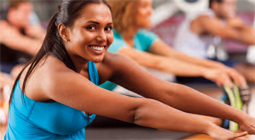
We all know that exercise is good for our overall health. However, Newton’s first Law of Motion states that every object will remain at rest or in uniform motion in straight lines unless compelled to change its state by the action of external forces. The human body was designed to move, so you will need to exert some force to get your body moving! That being said, here are a few specific ways that exercise (and I am aware that some of you don’t like the word “exercise”!), or “planned movement,” shall we say, can improve your quality of life.
Dr. Greenberg explains, “A healthy diet and exercise program is essential to health. Our bodies and physiology developed over hundreds of thousands of years to be incredible machines. They function despite tremendous abuse, but over time, this abuse takes a toll. A healthy diet along with exercise helps to control weight, improve cardiovascular health, and probably contributes to the health of the nervous system.”
The best exercise is the one that you will do on a consistent basis and that you will enjoy. Our lives are often too busy to make time for exercise. A fun way to recognize the countless benefits of movement is to learn how the puzzle pieces fit together, so you can see the big picture. We’ll first talk about how activity affects mood, and then go on to give you five puzzle pieces – each with an area of health that may benefit from exercise!

Putting it All Together
Kim Caffey was diagnosed with MS in 2007. She has been able to improve her health by attending some of MSAA’s educational events, featuring fitness and nutrition expert Amy McKay – who is also the author of this article. By employing her strategies for better nutrition and exercise, Kim has lost 30 pounds and is now enjoying a better quality of life!
While attending these MSAA educational events, Kim notes that she has learned about portion control, the importance of drinking water, and the value of exercise. According to Kim, “Making small changes to my bad eating habits helped a lot. I started exercising on the elliptical machine three times a week. There were some days that were hard but I pushed through them. If I was having a bad day, I would exercise sitting in a chair. My motto is ‘baby steps.’ One small change makes a world of difference! I feel better in general, which makes my MS more manageable. My goal is to live a long life.”
How Does Activity Affect Mood?
The Conversation between Brain and Body
By Charles Overstreet, PhD
Professor of Psychology
Tarrant County College, Fort Worth, Texas
Mental Health Consultant
A common question is, “Should I exercise if I have MS or will it make my symptoms worse?” Studies have shown that prescribed exercise, which is exercise that a physician recommends, does not appear to increase the severity of MS symptoms. Actually, increasing your activity can decrease your loss of function and increase strength and agility. Depression and anxiety can actually make symptoms of MS worse. While this sounds bad, the good news is that you can do something to counter these effects. Increasing activity and exercise has been shown to have positive effects on mood, including the reduction in the symptoms of both depression and anxiety in people with MS.
Let’s look at some positive effects of exercise on mood:
Exercise and activity increases resilience (hardiness) by providing body feedback that is the opposite of feeling weak. This raises confidence, which in turn reduces anxiety.
An increase in activity changes brain chemistry and can reduce symptoms of depression. Depression reduces motivation. Motivation reduces depression. Be motivated to be active, both physically and socially. The social isolation that results from pain and loss of function can cause depression. Activity, including exercise and social connection, can reverse symptoms of depression.
Emotion affects posture, but posture also affects emotion. So, a positive change in posture, as well as facial expressions, can have a positive effect on mood. Paying attention to posture by sitting-up straight, standing straight, keeping eyes raised, and making eye contact, along with a positive facial expression, can all have a profound effect on mood.
And…your thinking changes when you plan, carry out, and complete an exercise regime by increasing confidence. This requires you to be more proactive and gives you a sense of control, reducing anxiety. The disease causes you to be reactive and promotes pessimism. Being proactive promotes optimism, which is a much healthier state of mind.
Talk about it. Make positive statements to others about your progress. This changes your thinking and promotes positive changes in facial expressions and posturing, which encourages positive emotions. Even your tone of voice is a feedback loop. You hear your own voice when you speak – its pitch, loudness, and the content of your speech. Make a hopeless statement and you’ll become frustrated or sad. Optimistic statements tend to lift your mood.
Repetition and time are necessary for your new activity level to become familiar, so stick with it. Anticipate positive results. Take notice when there are signs of improvement in your functioning, including your daily activities, and enjoy the success!
 How the Benefits of Exercise
How the Benefits of Exercise
PIECE TOGETHER
for Overall Health
BLOOD PRESSURE |
|
HOW THIS PIECE FITS: Exercise dilates blood vessels. It also helps you burn excess fat, which further reduces blood vessel constriction. On average, losing five to ten pounds of weight leads to a drop in systolic pressure of up to eight points. This is the same amount that some blood pressure medications can achieve.
WHAT TO TRY: Exercises that get your heart rate up are ideal. Depending on your level of ability, try swimming, attending a water aerobics class, walking, cycling, or participating in armchair exercises. If possible, you may want to gradually work your way up to participating in exercise for three-to-four times per week, and for some, as much as 45 minutes per session. You will want to achieve a time period that works best for you, depending on your doctor’s recommendations… and enjoy a beneficial effect on blood pressure!
|
COGNITIVE PERFORMANCE |
|
HOW THIS PIECE FITS: Exercise promotes the growth of blood vessels in the brain, which can combat mild cognitive impairments. Researchers at the University of North Carolina at Chapel Hill School of Medicine took images of the brain in 14 older adults and found that those who were aerobically active had a greater number of small blood vessels. Their vessels were also wider, allowing for better blood flow, and had less “tortuosity” or twisting, which can weaken blood flow.
WHAT TO TRY: Learn any aerobic exercise that requires you to use your memory and coordination at the same time. Some may find dancing to be a fun way to exercise! You may feel like you have two left feet, or two left arms in the beginning, but it will become easier as your brain makes the connections with your muscles. By getting out of your comfort zone, you can enhance your overall fitness, and have fun at the same time. Remember that dancing with a cane, walker, or in a wheelchair is a great way to enjoy exercise as well!
|
ARTHRITIS |
|
HOW THIS PIECE FITS: Just like your muscles, your bones need blood supply to stay strong and healthy. Any physical activity increases blood flow and can therefore help your bones and joints receive oxygen and nutrients. Oxygen and nutrients can also help repair and rebuild damaged tissues.
WHAT TO TRY: Activities such as yoga, cycling, swimming, and water aerobics all offer movement that is constant, while providing the benefit of little to no impact on stiff or sore joints. Steering away from highimpact exercises is recommended. Aquatic exercise has the added benefits of buoyancy, a cool temperature, and other factors that can make it an ideal exercise for many individuals with MS. For tips and resources, please check out MSAA’s Swim for MS online Aquatic Center at aquatics.mymsaa.org.
|
GASTROINTESTINAL ISSUES |
|
HOW THIS PIECE FITS: When your body is moving, your gastro-intestinal (GI) system is moving as well. Exercise is one of the best tools used to combat constipation problems. Exercise also helps to relieve stress, so it can relieve some of the triggers associated with irritable bowel syndrome.
WHAT TO TRY: Exercises that use the lower extremities help the bowels move regularly and more efficiently. Walking, running, and cycling are all great choices, depending on your level of ability. If you have limited movement in your lower body, consider using passive assisted range-of-motion exercises. A licensed physical therapist or a certified Corrective Exercise Specialist could teach you this form of individualized exercise.
|
NEUROPATHY |
|
HOW THIS PIECE FITS: The secretion of inflammatory chemicals may trigger neuropathic pain. Regular exercise can reduce the secretion of these chemicals. Exercise also releases natural opioids in the brain that have a relaxing effect on the brain’s pain receptors.
WHAT TO TRY: A recent study at Louisiana State University found tai chi to be a great form of exercise for people with neuropathy. The slow, intentional, repetitive, and continuous patterns in tai chi bring a multitude of benefits to the participants.
|
MAINTAIN YOUR FRAME
Better Posture for Better Living
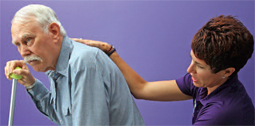
This picture demonstrates the poor posture that many people who use canes or walkers have. The spine is flexed forward creating added stress on each muscle connected to the spine. In addition, the field of vision is DOWN, instead of up and in front of you. Look up and out at the world around you!
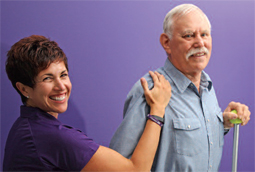
This photo shows proper posture with the support of an assistive device. Notice that the spine is in its proper alignment for functional and efficient movement throughout the day. It is also hard to hide the SMILE on his face because he feels better and is ready to face the day.
Have you ever wondered what your closet would look like if there were not any hangers for your clothes? All of your clothes would end up on the floor in a messy and unorganized pile. Within our bodies, our skeletal system acts like hangers, providing support for our muscles, connective tissues, and internal organs. Our skeletal system provides a structural framework for our bodies.
We need to keep our spines aligned to be able to enjoy the benefits that great posture can bring to our lives. Bad posture can make your neck creak and your shoulders ache, but recent research shows that the negative effects go well beyond what you might expect. So heads-up! Here are some interesting ways that posture can affect you – and ways you can get out of the slump.
A sad posture deepens depression
In a recent study from the San Francisco State University, students were told to either walk down a hall in a slouched position or to skip. The slouchers reported increased feelings of depression and lower energy than the skippers. In fact, even our language reflects this connection between proper posture and emotional affect – someone weak is called “spineless” and someone strong “has a backbone”!
The remedy: Imagine a flashlight right in the middle of your chest at the sternum. Sitting or standing, your flashlight should always shine directly forward. Now, keeping your head centered over your shoulders, extend the top of your head toward the ceiling, keeping your head level and not lifting your chin. Next, lift the corners of your mouth toward the sky… and SMILE!
A poor posture backs you up!
When you sit in a crunched position, your viscera (intestines) are folded up like an accordion and that can slow everything down!
The remedy: Yoga and Pilates are great forms of exercise to strengthen your core and help get things moving. One pose that can rev up a sluggish gut is the Cobra: lie on your belly while resting your head on your lower arms. Raise your forehead and look upwards, allowing your weight to rest on your chest. Letting your head fall back a little, raise your belly further off the mat, as if someone is behind you, lifting your shoulders up and back.
A lazy posture while watching television may impact your health.
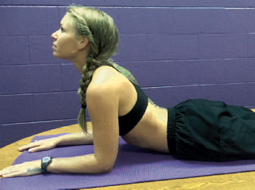
Cobra position
Some studies suggest that watching television for long periods of time while slouching on the couch, or spending too much time sitting still in front of the television, may increase your risk of certain health problems down the road, including diabetes and cardiovascular disease.
The remedy: Don’t let the TV tune you out! When you choose to watch television, as we all do, try to sit as tall as you can. For able-bodied individuals, you may try using a ball for support. This could also be a great time to rest in a “90/90” position. During commercial breaks, again if able, stand up from your chair; then sit down in a smooth and controlled motion. If you are in a wheelchair, try doing a bit of spinal rotation (please see photo and caption below) or alternating extensions.
A frumpy posture makes you appear heavier!
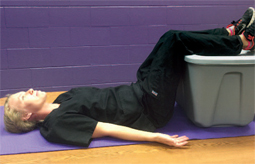
This photo demonstrates the 90/90 position: a 90 degree flexion at the hip and knee to decompress the lumbar spine.
Does this chair make me look fat? Well, yes, but only if you are slumped over in it! We’ve become a nation of professional sitters… when you are slouched over, your internal organs have nowhere to go but down and out, so you immediately appear less fit!
The remedy: The solution for this one is simple. Get up if you can and move as much as you can. When we stand or sit tall – and this applies to sitting in a standard chair or in a wheelchair – as opposed to sitting with poor posture, we burn 20-percent more calories! By doing so, we also strengthen our muscles, boost metabolism, and increase bone density.
A constricting posture cuts off circulation.
Our bodies are machines that move fluid and gases back and forth. Prolonged sitting, especially with your legs crossed, can cut off the flow, increase pressure in your abdominal wall, and even cause spider veins and tingling in your legs.
The remedy: To get blood flowing to your lower body, stand up and find your best posture, then lift one leg up so your thigh is horizontal to the ground, keeping your knee bent so your calf and foot hang down. Keep your standing leg locked (but not hyper-extended) and hold for five strong breaths, pushing your breathing down to your diaphragm. Repeat on the opposite side. If you are in a wheelchair and are able, try extending the leg while sitting with a lengthened spine. Another important strategy is to try to break the habit of sitting with your legs crossed. This simple act allows oxygenated blood to flow freely.
A crumpled posture stresses you out!
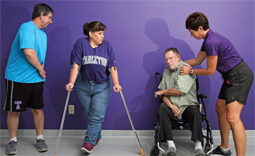
This photo demonstrates spinal rotation. Spinal rotation is a fantastic exercise to stimulate range of motion and flexibility in our spine. It is also very helpful at stimulating your internal organs to function more efficiently and effectively. Visualize your spine as a spiral stair case that extends to the sky as you rotate. If needed, a physical therapist can teach you how to perform spinal rotation on your own.
A recent study from Harvard showed that people who adopted powerful postures (open shoulders and straight spines) experienced a 20-percent increase in testosterone levels (related to strength) and a 25-percent decrease in cortisol levels (related to stress). Conversely, people who slouched had a 10- percent decrease in testosterone and a 15-percent increase in cortisol. This hormonal imbalance can even affect how you feel, potentially reducing your self-confidence and your ability to deal with daily stressors. Sitting in a slouched posture can compound the problem. Shallow chest-breathing strains the lungs – and your lungs must move faster to ensure adequate oxygen flow. This rapid breathing taxes the heart, forcing it to speed up to provide enough blood for oxygen transport. The result is a vicious cycle, where stress prompts shallow breathing, which in turn creates more stress.
The remedy: Take relaxed abdominal breaths to combat stress. Here’s how to make sure you’re breathing deeply: Rest your hand below your belly button; you should feel your belly expand as you inhale. Invite the air all the way down to the deepest portion of the lungs, where oxygen exchange is most efficient. As you exhale, you should feel your belly contract again, along with the feeling of stress leaving your body.
Tips for a Healthy Spine
The following five easy tips will help you to minimize complications from any back conditions you may have, while helping to prevent future painful episodes.
- Let your spine relax while sleeping. While you’re sleeping, all the structures in your spine that have worked hard all day finally have an opportunity to relax and be rejuvenated. Using the right mattress and pillow will support the spine so the muscles and ligaments can be stress-free and have a chance to become refreshed.
In a recent MSAA patient-education program, Dr. Ben Greenberg shared his thoughts on sleep. “Outside of watching what we eat and remaining active, I think the three most important things we can do for health are to maintain adequate and good-quality sleep, adequate hydration, and a positive outlook. People underestimate the need for good quality, uninterrupted sleep and its impact on cognition, energy, mood, and overall health.”
- Choose your shoes carefully. Whether walking for exercise or to get somewhere, the shoes you wear have a big effect on your back. They should be well-balanced, flexible, and most certainly comfortable. Good shoes not only provide protection for your feet, but also a supportive base that helps the spine and body remain in alignment.
- Enjoy the benefits of massage. Many people love a good massage to relax their muscles and relieve stress. Therapeutic massages not only improve flexibility and decrease tension; they can also improve blood flow and increase the level of endorphins in your bloodstream, which are chemicals in the body that make us feel good.
- Sit up straight – with support. The discs in your lower spine are loaded threetimes more while sitting than standing, so long periods of sitting can often create or aggravate a painful back condition. Moreover, when sitting in an office chair, many people slouch and lean forward, and this poor posture usually leads to muscle tension and pain in the lower back and legs. Place a foam ball between the back of the chair and just below your shoulder blades to support your thoracic spine. Your thoracic spine is the upper portion of your back, made up of the twelve vertebrae that run from the base of your neck to just above your waistline.
- Specifically exercise your abs and back. One of the most important components of good spine health is exercise. Specifically, performing abdominal and back exercises will go far in helping to keep your spine healthy. A physical therapist or other health specialist is able to recommend a simple routine that is best for you, and these exercises can often be performed in seven minutes as part of a daily routine. If your back and abdominal muscles are not in good shape, this may create additional pressure on the spine, which is already under the stress of supporting your entire body. When these muscles are well maintained, they help support the spine and minimize the chance of injury.
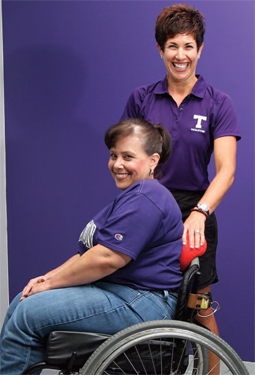
This picture demonstrates the proper placement of an 8-inch foam ball that can be purchased anywhere. By placing the foam ball in the middle of the upper back, the chest instantly expands and the spine is lengthened while being supported. This technique can be used anytime prolonged sitting is in your day. I use one during my commute and it creates a comfortable and efficient posture for deep breathing and spinal health.
Follow these simple guidelines to protect your back and help keep it in good shape:
- Standing… keeping one foot about four inches apart from the other, with knees slightly bent, takes the pressure off your lower back.
- Sitting… sitting with your knees slightly higher than your hips provides good support for your lower back. Reaching… if able to do so safely, stand on a stool to reach things that are above your shoulder level, to avoid straining your back.
- Moving Heavy Items… pushing is easier on your back than pulling. Use your arms and legs to start the push. If you must lift a heavy item, please ask someone to help.
- Lifting… if able to do so safely, kneel down on one knee with the other foot flat on the floor as near as possible to the item you are lifting. Lift with your legs, not your back, keeping the object close to your body at all times.
- Carrying… breaking down a larger load into smaller items to carry, and carrying these lighter or smaller items in each hand, may be easier to handle than one large item. If you must carry one large object, keep it close to your body. Of course, if it is at all risky or you feel any type of strain, please ask someone to help.
- Sleeping… sleeping on your back puts 55 pounds of pressure on your back. If appropriate for you, placing a couple of pillows under your knees cuts the pressure in half. Lying on your side with a pillow between your knees also reduces the pressure.
- Weight Control… additional weight puts a strain on your back. If able, individuals should try to keep within 10 pounds of their ideal weight for a healthier back.
- Quit Smoking… smokers are more prone to back pain than nonsmokers; this is because nicotine restricts the flow of blood to the discs that cushion your vertebrae.
In Summary
MSAA Chief Medical Officer Dr. Jack Burks explains, “This article is a must-read for people with MS and others who are trying to navigate the complex waters of nutrition and health. It also includes very helpful tips on exercise and posture.
Remember!
These guidelines are the same whether you have full mobility and need no assistance, or if you use a cane, walker, or wheelchair. If the latter, please consult a physical therapist or a corrective exercise specialist in your area to ensure that your assistive device is specifically adjusted to fit your body size, allowing you to enjoy the benefits of optimal postural alignment. Sit and/or stand tall! Be proud of the beautiful, smart, and strong person you are. Lengthen your spine and align with a healthy lifestyle.
“Providing a foundation for healthy eating, this information may be beneficial in many ways. However, knowing which diet is best for your individual situation may be difficult. The table detailing each diet may help you to choose the diet – or the components of different diets – that is best for you. A nutritionist with MS expertise may help guide your decisions. The take-home message for me is this: paying more attention to diet may help your general health as well as your MS. Reducing your intake of processed food and salt are great places to start. In addition, exercise and better posture can make a big difference.”
Dr. Bromley adds, “The best medicine for your body is a healthy lifestyle. Implementing changes very gradually is the key – and increases the likelihood of success! Very restrictive diets and high-intensity exercise, although good for some people, are difficult to adhere to.
“Improving nutrition, increasing water intake if needed, getting outdoors, decreasing stress, and finding enjoyable activities to get adequate exercise, have all been shown to assist the body in running efficiently. Small steps can really add up, ultimately giving you control over how you feel. You can do it!”

